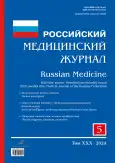Microglia and macrophages in the human pineal gland
- 作者: Sufieva D.A.1, Fedorova E.A.1, Yakovlev V.S.1, Grigorev I.P.1, Korzhevskii D.E.1
-
隶属关系:
- Institute of Experimental Medicine
- 期: 卷 30, 编号 5 (2024)
- 页面: 455-463
- 栏目: Original Research Articles
- URL: https://bakhtiniada.ru/0869-2106/article/view/277123
- DOI: https://doi.org/10.17816/medjrf634587
- ID: 277123
如何引用文章
详细
BACKGROUND: Over the past two decades, inflammatory responses in the central nervous system (CNS) have been shown to play a role in the etiology of most neurological and psychiatric diseases, as well as in the aging process. Microglia and macrophages are the most important immune cells in the CNS. In contrast to the role of microglia and macrophages in various parts of the CNS, the human pineal gland has not been studied.
AIM: To evaluate the morphological characteristics, types and localization of microglial cells in the human pineal gland by immunohistochemistry.
MATERIALS AND METHODS: The study was performed using samples of a pineal gland of the human brain obtained in individuals between the ages of 16 and 61 years (n=7). Immunohistochemistry was performed on pineal gland sections using antibodies against Iba1 and TMEM119, selective markers for microgliocytes. Statistical methods were used to evaluate the frequency of immunostained cells.
RESULTS: The majority of phagocytic cells identified by immunohistochemistry were found to be microglia and not macrophages. Microglia are represented by both inactive and activated forms. Microglia in the human pineal gland are typically localized in connective tissue trabeculae, both near and far from blood vessels. Microgliocytes are also found in the pineal parenchyma in the hormone-synthesizing cells of the pinealocytes. The number of Iba1 and especially TMEM119 immunoreactive cells decreased significantly with age.
CONCLUSION: This study is the first to evaluate microglia and macrophages in the human pineal gland. The prevalence of microglial cells over macrophages was found. The morphological characteristics and localization of the identified microglial cell types suggest their involvement primarily in immune defense and probably also in the regulation of pinealocyte functions. In addition, there are data suggesting the involvement of microglial cells in the development of inflammation in the human pineal gland during aging.
作者简介
Dina Sufieva
Institute of Experimental Medicine
编辑信件的主要联系方式.
Email: dinobrione@gmail.com
ORCID iD: 0000-0002-0048-2981
SPIN 代码: 3034-3137
Cand. Sci. (Biology)
俄罗斯联邦, Saint PetersburgElena Fedorova
Institute of Experimental Medicine
Email: el-fedorova2014@yandex.ru
ORCID iD: 0000-0002-0190-885X
SPIN 代码: 5414-4122
Scopus 作者 ID: 36901775900
Researcher ID: B-1671-2012
Cand. Sci. (Biology)
俄罗斯联邦, Saint PetersburgVladislav Yakovlev
Institute of Experimental Medicine
Email: 1547053@mail.ru
ORCID iD: 0000-0003-2136-6717
SPIN 代码: 7524-9870
俄罗斯联邦, Saint Petersburg
Igor Grigorev
Institute of Experimental Medicine
Email: ipg-iem@yandex.ru
ORCID iD: 0000-0002-3535-7638
SPIN 代码: 1306-4860
Cand. Sci. (Biology)
俄罗斯联邦, Saint PetersburgDmitrii Korzhevskii
Institute of Experimental Medicine
Email: dek2@yandex.ru
ORCID iD: 0000-0002-2456-8165
SPIN 代码: 3252-3029
Scopus 作者 ID: 12770589000
Researcher ID: C-2206-2012
MD, Dr. Sci. (Medicine), Professor of Russian Academy of Sciences
俄罗斯联邦, Saint Petersburg参考
- Norman AW, Henry HL. The pineal gland // Hormones. 3rd ed. London, England: Academic Press; 2015. P. 351–361. doi: 10.1016/B978-0-08-091906-5.00016-1
- Markus RP, Fernandes PA, Kinker GS, et al. Immune-pineal axis — acute inflammatory responses coordinate melatonin synthesis by pinealocytes and phagocytes. Br J Pharmacol. 2018;175(16):3239–3250. doi: 10.1111/bph.14083
- Duvernoy HM, Parratte B, Tatu L, Vuillier F. The human pineal gland: relationships with surrounding structures and blood supply. Neurol Res. 2000;22(8):747–790. doi: 10.1080/01616412.2000.11740753
- Wolf SA, Boddeke HW, Kettenmann H. Microglia in physiology and disease. Annu Rev Physiol. 2017;79:619–643. doi: 10.1146/annurev-physiol-022516-034406
- Gao C, Jiang J, Tan Y, Chen S. Microglia in neurodegenerative diseases: mechanism and potential therapeutic targets. Signal Transduct Target Ther. 2023;8(1):359. doi: 10.1038/s41392-023-01588-0
- Jurga AM, Paleczna M, Kuter KZ. Overview of general and discriminating markers of differential microglia phenotypes. Front Cell Neurosci. 2020;14:198. doi: 10.3389/fncel.2020.00198
- Guselnikova VV, Fedorova EA, Safray AE, et al. Distribution of transmembrane protein 119 (TMEM-119) in microgliocytes of human cerebral cortex with amyloid plaques. Biologicheskie Membrany. 2021;38(5):340–350. EDN: IVUNUM doi: 10.31857/S0233475521040058
- Muñoz EM. Microglia in circumventricular organs: the pineal gland example. ASN Neuro. 2022;14:17590914221135697. doi: 10.1177/17590914221135697
- DePaula-Silva AB, Gorbea C, Doty DJ, et al. Differential transcriptional profiles identify microglial- and macrophage-specific gene markers expressed during virus-induced neuroinflammation. J Neuroinflammation. 2019;16(1):152. doi: 10.1186/s12974-019-1545-x
- González Ibanez F, Picard K, Bordeleau M, et al. Immunofluorescence staining using IBA1 and TMEM119 for microglial density, morphology and peripheral myeloid cell infiltration analysis in mouse brain. J Vis Exp. 2019;(152). doi: 10.3791/6449 Erratum in: J Vis Exp. 2019;(152). doi: 10.3791/60510
- Kenkhuis B, Somarakis A, Kleindouwel LRT, et al. Co-expression patterns of microglia markers Iba1, TMEM119 and P2RY12 in Alzheimer's disease. Neurobiol Dis. 2022;167:105684. doi: 10.1016/j.nbd.2022.105684
- Satoh J, Kino Y, Asahina N, et al. TMEM119 marks a subset of microglia in the human brain. Neuropathology. 2016;36(1):39–49. doi: 10.1111/neup.12235
- Bisht K, Okojie KA, Sharma K, et al. Capillary-associated microglia regulate vascular structure and function through PANX1-P2RY12 coupling in mice. Nat Commun. 2021;12(1):5289. doi: 10.1038/s41467-021-25590-8
- Ibañez Rodriguez MP, Noctor SC, Muñoz EM. Cellular basis of pineal gland development: emerging role of microglia as phenotype regulator. PLoS One. 2016;11(11):e0167063. doi: 10.1371/journal.pone.0167063
- Sufieva DA, Fedorova EA, Yakovlev VS, Grigorev IP. Immunohistochemical study of human pineal vessels. Medical Academic Journal. 2023;23(2):109–118. EDN: RETHOC doi: 10.17816/MAJ352563
- Crapser JD, Arreola MA, Tsourmas KI, Green KN. Microglia as hackers of the matrix: sculpting synapses and the extracellular space. Cell Mol Immunol. 2021;18(11):2472–2488. doi: 10.1038/s41423-021-00751-3
- Nguyen PT, Dorman LC, Pan S, et al. Microglial remodeling of the extracellular matrix promotes synapse plasticity. Cell. 2020;182(2):388–403.e15. doi: 10.1016/j.cell.2020.05.050
- Tsai SY, McNulty JA. Microglia in the pineal gland of the neonatal rat: characterization and effects on pinealocyte neurite length and serotonin content. Glia. 1997;20(3):243–253. doi: 10.1002/(sici)1098-1136(199707)20:3<243::aid-glia8>3.0.co;2-8
- Tsai SY, O'Brien TE, McNulty JA. Microglia play a role in mediating the effects of cytokines on the structure and function of the rat pineal gland. Cell Tissue Res. 2001;303(3):423–431. doi: 10.1007/s004410000330
- Maheshwari U, Huang SF, Sridhar S, Keller A. The interplay between brain vascular calcification and microglia. Front Aging Neurosci. 2022;14:848495. doi: 10.3389/fnagi.2022.848495
补充文件










